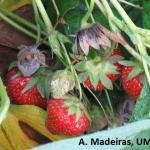Strawberry IPM- Gray Mold
Gray mold, caused by the fungus Botrytis cinerea, is a disease of many crop species. It can be a serious problem for the strawberry grower, especially in the Northeast where cool, damp spring weather is ideal for disease development. Disease can strike at any time during the growing season when weather conditions are right. Gray mold can cause significant crop loss both pre- and post-harvest.
Disease Cycle
The fungus overwinters in plant debris. In spring, it produces spores that are dispersed by wind and rain splash. These spores germinate and can infect blossoms and leaves. The optimum temperature for infection is 60-77°F, and spores can infect in as little as 6 hours when leaves are wet. New leaves and blossoms are especially vulnerable, but the pathogen can infect any part of the plant. After infection, the fungus remains quiescent in plant tissues until they begin to die due to things such as frost, mechanical damage, or natural senescence. Fruit that develops from infected flowers will harbor latent infections that become active when fruit ripens. Secondary infections can occur any time during the growing season when the weather is cool and moist.
Signs and Symptoms
Infected plant parts become covered with fuzzy white or gray mycelium and abundant gray spores. Blighted blossoms lose their petals and turn brown. Infected fruit will shrivel and mummify, but often remain attached to the plant.
Management
Cultural
Plant in full sun. Proper plant spacing and good weed control increase air circulation, which decreases humidity and facilitates drying of plant surfaces. Plant in raised beds and use drip irrigation if possible in order to avoid wetting leaves and blossoms. Organic mulch such as straw can protect fruit from soil contact and diminish splashing of inoculum from the soil onto plants. Till in dead plant material at renovation to avoid long term buildup of inoculum in the field. Minimize nitrogen fertilization in spring to avoid overgrowth of foliage which creates a dense, shaded and moist canopy and higher levels of infection. Apply needed fertilizer after harvest during the renovation period and then again in late summer to support flower bud formation for the following year. Harvest in dry weather, handle fruit gently, and refrigerate immediately.
Chemical
Along with proper cultural and sanitation practices, fungicides are crucial for protection against blossom blight. A treatment should be applied at early bloom (10%), then again 7-10 days later at full bloom. If possible, spray 24 to 48 hours before rain is predicted to fall. See the New England Tree Fruit Management Guide for current recommendations on products labeled for gray mold on strawberry. As a general rule, do not make more than 2 consecutive applications of the same product Rotation of active ingredients is imperative for the prevention of resistance development.
Control options for organic and low-spray growers are somewhat limited. Sulfur and copper compounds are not very effective for gray mold control; in addition, these compounds can cause phytotoxic damage to leaves and fruit. Actinovate-AG (Streptomyces lydicus WYEC 108s) may provide some level of control and has best efficacy when applied with a spreader/sticker prior to an anticipated infection period. Several biological control products are available, but evidence of their effectiveness is lacking. Trichoderma harzianum products are used as a biocontrol agent in Europe and Israel. A good source for current recommendations for organic production is the Cornell Organic Strawberry Production Guide which can be found at https://ecommons.cornell.edu/handle/1813/42890. A few cultivars are considered less susceptible to gray mold. These include Allstar, Earliglow, and Jewel. Growers concerned with fungicide input on their properties may consider growing a less susceptible variety.


